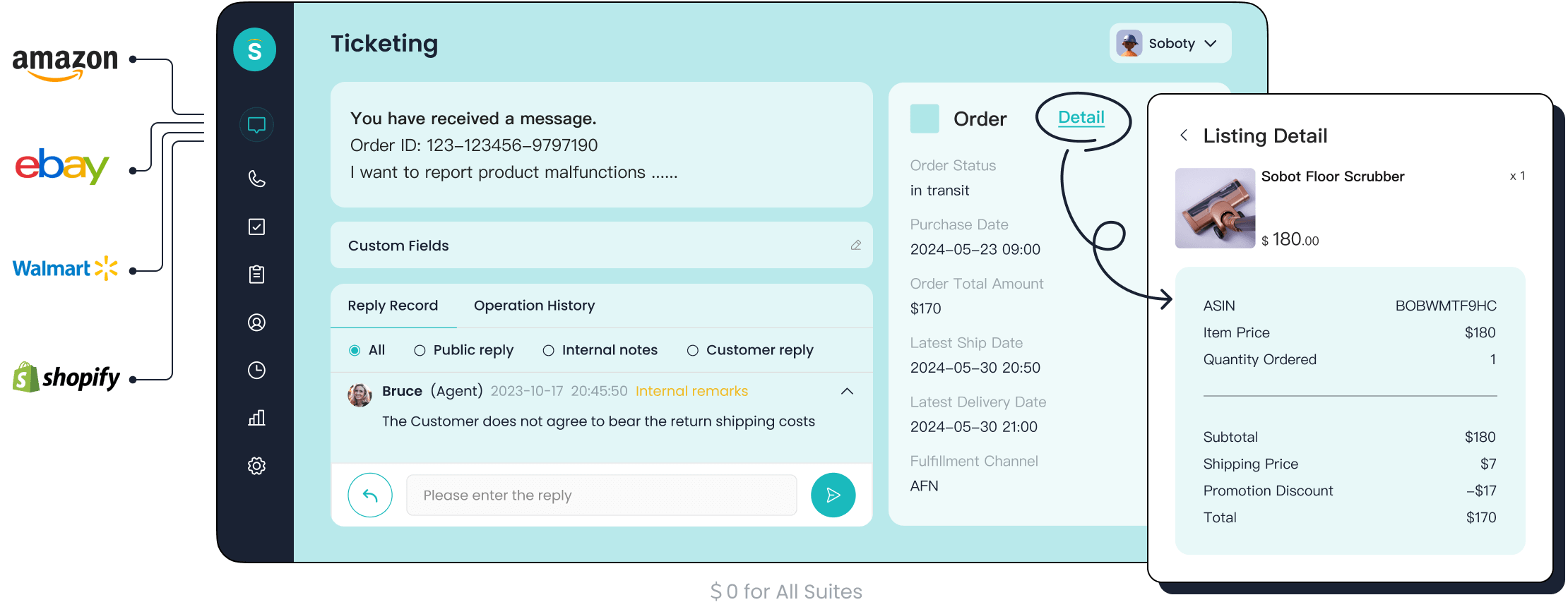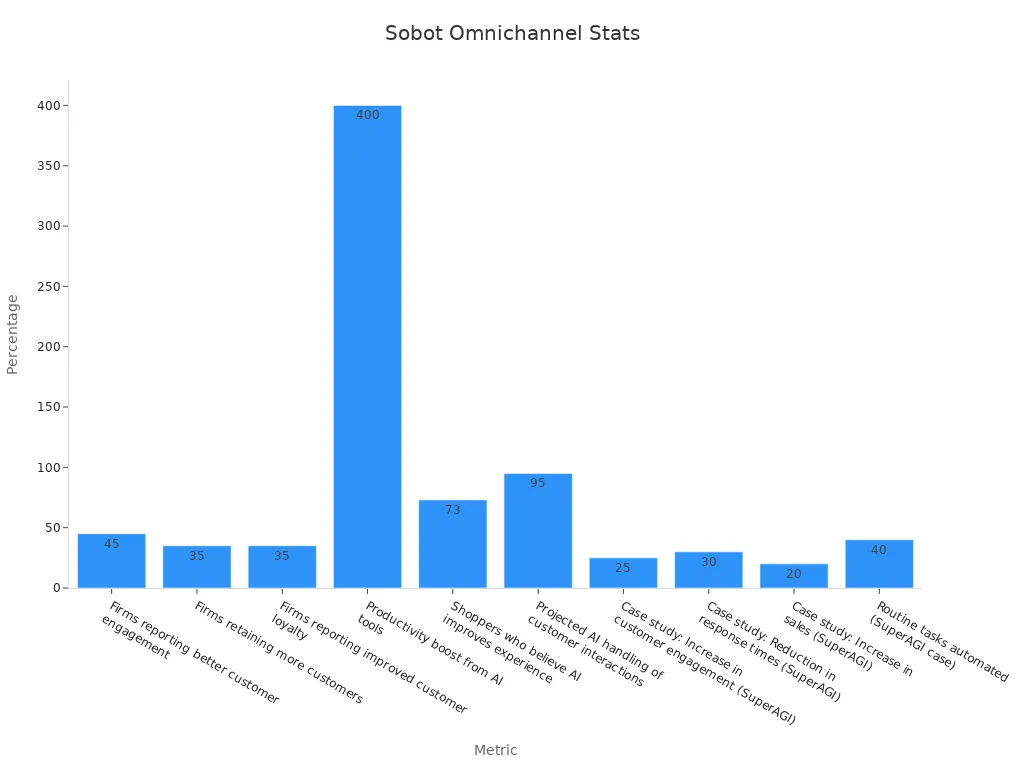Client Success Manager vs Customer Success Manager Roles Explained

A Client Success Manager typically manages long-term business relationships with organizations, while a Customer Success Manager focuses on individual end-user satisfaction. This distinction matters for companies using Sobot, as Sobot AI empowers teams to deliver seamless customer experiences across channels. Choosing the right role impacts service quality, support efficiency, and ecommerce outcomes. For example, a clear job description for customer success manager helps define responsibilities and drive measurable results.
Client Success Manager
Role Overview
A Client Success Manager plays a vital role in contact center operations. This professional guides new clients through onboarding, helping them understand product features and accelerating adoption. The Client Success Manager sets a vision for success by learning about client goals and building a formal plan with clear KPIs. They act as the voice of the client, gathering feedback and sharing it with internal teams. Their work ensures long-term relationships and contract renewals. In many organizations, the Client Success Manager also identifies upsell and cross-sell opportunities that align with client needs. They build strong connections with support, product, marketing, and sales teams to deliver a seamless experience.
A Client Success Manager bridges the gap between sales and support, ensuring every client receives the attention and guidance needed for success.
Responsibilities
Client Success Managers have a broad set of responsibilities that drive business growth and customer satisfaction. Some key tasks include:
- Onboarding new clients and setting clear expectations for success.
- Monitoring client engagement and product usage to address issues early.
- Building loyalty and reducing churn through ongoing relationship management.
- Advocating for clients by communicating their needs to product teams.
- Identifying upsell and cross-sell opportunities that fit client goals.
- Collaborating with other departments to ensure a customer-centric approach.
- Resolving moderately complex problems and tailoring solutions to specific industries.
Statistics show that 25% to 30% of executives with direct client contact are compensated based on customer retention KPIs. Organizations that prioritize customer success have grown their focus from 10% in 2015 to 47% in 2020 (source). Improving customer retention by just 5% can boost company earnings by up to 95%.
Skills Needed
A successful Client Success Manager needs a blend of interpersonal, strategic, technical, and analytical skills. Essential abilities include:
- Relationship building and active listening
- Empathy and effective communication
- Strategic account management and planning
- Deep product knowledge and CRM proficiency
- Data analytics and business process understanding
- Project management and organizational skills
- Adaptability and proactive problem-solving
These skills help Client Success Managers drive retention, satisfaction, and growth. Sobot’s unified contact center solutions support these professionals by providing tools for onboarding, workflow automation, and analytics, making it easier to deliver outstanding client experiences. Both Client Success Manager and Customer Success Manager roles benefit from platforms like Sobot, which streamline communication and support across channels.
Customer Success Manager
Role Overview
A Customer Success Manager (CSM) ensures customers achieve their goals with a company’s products or services. The CSM acts as a bridge between clients and internal teams such as operations, technology, and sales. This role focuses on creating a seamless customer experience and building long-term relationships.
- Develops strategic account plans that focus on business outcomes.
- Monitors customer satisfaction and retention using data and key performance indicators.
- Manages onboarding and integration processes for new customers.
- Supports ecommerce fulfillment by managing product catalogs and overseeing deliveries.
- Collaborates across teams to maximize partnership success.
The CSM role requires proactive client advocacy and the ability to manage multiple priorities in a fast-paced environment.
Job Description for Customer Success Manager
The job description for customer success manager includes a wide range of responsibilities. CSMs track important metrics such as customer churn rate, monthly recurring revenue (MRR), and customer feedback. These metrics help measure the effectiveness of customer relationship management and account growth.
- Reduce customer churn by addressing issues quickly and maintaining strong relationships.
- Increase MRR by identifying upsell opportunities and expanding accounts.
- Collect and analyze customer feedback to improve products and services.
- Deliver regular reports to clients and internal teams.
- Ensure contract compliance and manage cross-functional projects.
The job description for customer success manager often highlights the need for experience in enterprise-level customer success. Companies look for candidates who have a proven track record of exceeding sales and satisfaction goals. Sobot’s omnichannel solutions and ticketing system help CSMs manage customer interactions, automate workflows, and monitor key metrics like NPS, CSAT, and retention rates. These tools support the job description for customer success manager by making it easier to deliver excellent service and drive business growth.
| Metric Name | Description | Relevance to CSM Role |
|---|---|---|
| Net Promoter Score (NPS) | Measures customer loyalty and likelihood to recommend | Guides CSMs to improve relationships and retention |
| Customer Satisfaction (CSAT) | Measures satisfaction with interactions or overall experience | Helps CSMs enhance happiness and loyalty |
| Monthly Recurring Revenue (MRR) | Predictable monthly revenue from customers | Tracks account growth and revenue expansion |
Skills Needed
Customer Success Managers need a mix of technical and interpersonal skills. They must understand ecommerce and fulfillment environments, especially in fast-paced industries.
- Relationship management and empathy
- Active listening and clear communication
- Technical proficiency to explain complex processes
- Resourceful problem-solving and project management
- Data-driven decision making
Sobot provides CSMs with unified workspaces, AI-driven chatbots, and analytics. These features help CSMs manage multiple priorities, deliver personalized service, and improve customer satisfaction.
Key Differences

Client vs Customer Focus
The distinction between a Client Success Manager and a Customer Success Manager begins with their core focus. A Client Success Manager works closely with organizations, managing relationships with key stakeholders and aligning services to strategic business goals. This role proactively shapes client strategies, ensuring long-term value and adoption of solutions like Sobot’s omnichannel platform. In contrast, a Customer Success Manager typically supports individual end-users, focusing on satisfaction, loyalty, and immediate support needs.
| Aspect | Client Focus (Success Management) | Customer Focus (Traditional Management) |
|---|---|---|
| Goal Orientation | Proactively manages client goals, shaping strategies for long-term value. | Reactively focuses on satisfaction and immediate needs. |
| Stakeholder Management | Engages multiple stakeholders within the client organization. | Focuses on individual customer interactions. |
| Learning Management | Supports onboarding and continuous learning for adoption. | Provides reactive support as issues arise. |
| Performance Metrics | Uses predictive indicators like adoption rates and retention. | Relies on satisfaction and loyalty scores. |
| Organizational Role | Integrates marketing, sales, and support for proactive success. | Roles are often siloed and reactive. |
A Client Success Manager acts as a strategic partner, while a Customer Success Manager ensures every customer receives timely support.
Account Management Scope
Client Success Managers and Customer Success Managers differ in the scale and complexity of accounts they manage. A Client Success Manager typically handles a smaller number of high-value, complex accounts. These accounts require personalized attention, frequent communication, and tailored solutions. For example, Sobot’s enterprise clients, such as Michael Kors, benefit from dedicated Client Success Managers who oversee integration, adoption, and ongoing optimization.
Customer Success Managers, on the other hand, manage a larger volume of smaller or less complex accounts. They rely on standardized processes and digital tools, such as Sobot’s ticketing system, to efficiently support many customers at once. This approach allows for scalable service delivery and consistent customer experiences.
| Aspect | Client Success Manager | Customer Success Manager |
|---|---|---|
| Scope of Responsibility | Fewer, high-value, complex accounts | Larger volume of smaller, less complex accounts |
| Level of Customization | Highly personalized, bespoke services | Standardized, scalable processes |
| Communication Frequency | Frequent, in-depth, strategic meetings | Periodic, often automated communication |
| Client Interaction | Works with decision-makers and key stakeholders | Supports broader customer base |
Sobot’s unified workspace empowers both roles to manage their unique account scopes efficiently, ensuring no customer or client is left behind.
Strategic vs Transactional Approach
A Client Success Manager adopts a strategic, high-touch approach. This role involves regular business reviews, long-term planning, and partnership development. The Client Success Manager becomes a trusted advisor, guiding clients through complex decisions and aligning Sobot’s solutions with their evolving needs. For instance, they may help a retail client integrate Sobot’s AI-powered chatbots to improve customer engagement and drive business outcomes.
A Customer Success Manager, by contrast, operates with a more transactional, process-driven mindset. The focus remains on resolving issues quickly, maintaining satisfaction, and supporting day-to-day operations. Automated workflows, such as those found in Sobot’s ticketing system, help Customer Success Managers deliver fast, consistent service across channels.
| Approach | Client Success Manager | Customer Success Manager |
|---|---|---|
| Partnership Level | High-touch, strategic | Scalable, process-driven |
| Communication Style | In-depth, consultative | Efficient, often automated |
| Example Activities | Business reviews, strategy | Ticket resolution, onboarding |
The job description for customer success manager often emphasizes efficiency and scalability, while the Client Success Manager role highlights strategic partnership and long-term growth.
By understanding these key differences, organizations can better align their customer engagement strategies and leverage solutions like Sobot to maximize both client and customer success.
Similarities
Shared Goals
Client Success Managers and Customer Success Managers share many of the same goals. Both roles focus on building strong relationships, improving customer satisfaction, and driving business growth. They use key metrics like customer retention rates, net retention, churn rates, and renewal rates to measure their impact. These professionals align customer goals with company objectives, using data-driven decision-making to guide their actions. For example, both roles use customer health scores and success playbooks to track progress and identify areas for improvement. Sobot’s unified contact center solutions help both Client Success Managers and Customer Success Managers monitor these metrics in real time, making it easier to deliver consistent results. Their shared focus on continuous improvement and proactive engagement ensures that customers and clients receive the best possible experience.
Overlapping Skills
Both Client Success Managers and Customer Success Managers need a similar set of skills to succeed. They must excel at relationship building, active listening, and clear communication. Strategic thinking and a consultative approach help them understand customer needs and offer tailored solutions. These professionals also rely on data analytics to measure success and identify trends. Problem-solving and adaptability are essential, especially when managing complex accounts or resolving issues quickly. Sobot’s ticketing system supports these skills by automating workflows and providing detailed analytics, allowing both roles to focus on high-value activities. The job description for customer success manager often highlights these overlapping skills, showing how important they are for driving customer satisfaction and loyalty.
Customer Retention
Customer retention stands as a top priority for both Client Success Managers and Customer Success Managers. They use a repeatable process that includes knowing the customer, taking action, and measuring results. This approach involves strong communication and collaboration across departments. For example, they may set KPIs to achieve a 95% retention rate or increase Net Promoter Score (NPS) by 10 points in a year. Sobot’s omnichannel platform and ticketing system make it easy to track these KPIs and manage customer interactions efficiently. By focusing on onboarding, strategic planning, and ongoing engagement, both roles help companies like Michael Kors achieve high satisfaction and loyalty. Their efforts lead to measurable outcomes, such as increased renewals, revenue growth, and positive referrals.
Tools and Solutions with Sobot


Sobot Ticketing System
The Sobot Ticketing System helps both Client Success Managers and Customer Success Managers manage support requests efficiently. This system unifies all communication channels, making it easy to track and resolve issues. Automation features, such as AI-powered ticket routing and SLA management, reduce manual work and speed up response times.
| Performance Metric | Before Automation | After Automation | Improvement (%) |
|---|---|---|---|
| First Response Time (min) | 15 | 2 | 86.7 |
| Resolution Time (min) | 60 | 30 | 50 |
| Customer Satisfaction (CSAT) Score (%) | 75 | 85 | 13.3 |
| Resolution Rate (%) | 60 | 80 | 33.3 |
| Escalation Rate (%) | 20 | 5 | 75 |
These results show how the Sobot Ticketing System improves speed, satisfaction, and automation for both client and customer success management. Features like multilingual support, analytics, and canned responses help teams deliver consistent service. The job description for customer success manager often includes using such tools to boost efficiency and customer happiness.
Omnichannel Support
Sobot’s Omnichannel Solution gives businesses a single platform to manage all customer interactions. This solution supports voice, email, chat, and social media, allowing Client Success Managers and Customer Success Managers to provide seamless support. AI-driven automation handles routine tasks, freeing up agents to focus on complex issues.

- 45% of firms report better customer engagement.
- 35% see improved retention and loyalty.
- AI tools boost productivity by up to 400%.
- 73% of shoppers believe AI improves their experience.
These statistics highlight how Sobot’s Omnichannel Support drives strong results for both client and customer success.
Real-World Example: Michael Kors
Michael Kors, a global fashion brand, improved its customer service using Sobot’s all-in-one platform. The company unified its support channels and integrated live chat with the Sobot Ticketing System. As a result, Michael Kors reduced response times by 83% and achieved a 95% customer satisfaction rate. The brand also saw a 20% increase in conversion rates after using Sobot’s WhatsApp API for marketing. This real-world example shows how Sobot empowers both Client Success Managers and Customer Success Managers to deliver outstanding results.
Sobot’s solutions help brands like Michael Kors build loyalty, improve efficiency, and achieve measurable business growth.
Choosing the Right Role
Business Needs
Selecting between a Client Success Manager and a Customer Success Manager starts with understanding business needs. Companies must identify their core objectives and align them with measurable outcomes. For example, organizations often focus on metrics such as Conversion Rate, Customer Lifetime Value, and Churn. Setting SMART targets for each KPI ensures progress is clear and actionable. Regular monitoring and analysis of these metrics help leaders adapt strategies and improve results.
- Define business objectives and select relevant customer engagement metrics.
- Set specific, measurable, achievable, relevant, and time-bound targets.
- Monitor and analyze trends to guide decision-making.
- Adjust strategies based on performance data.
- Integrate KPIs across departments for unified efforts.
- Use customer engagement platforms with real-time analytics, like Sobot, to gain deeper insights.
A Customer Success Manager role often fits companies aiming to improve customer retention, scale support teams, and deliver ongoing value. The job description for customer success manager should reflect these priorities. Sobot’s omnichannel solutions and ticketing system provide the analytics and automation needed to track and achieve these goals.
Industry Context
Industry context shapes the choice between Client Success Manager and Customer Success Manager roles. In B2B and digital-first sectors, companies rely on comprehensive customer and sales data to inform decisions. Data governance frameworks ensure information is secure and consistent, supporting compliance and operational efficiency.
- Data relationships reveal patterns that guide resource allocation.
- The purpose of data, such as marketing or compliance, influences role requirements.
- Digital interaction data helps organizations identify opportunities and improve engagement.
Sobot’s unified contact center solutions help businesses in retail, finance, and ecommerce manage customer data securely and efficiently. By leveraging these tools, companies can align their success management roles with current market demands and regulatory standards.
Hybrid Models
Many organizations now adopt hybrid models that combine elements of both roles. This approach blends strategic account management with scalable customer support. Companies like Warby Parker and Amazon Go have shown that hybrid engagement reduces delivery costs by 23% and increases online interactions by 37%.
- 91% of consumers research products online before buying in stores.
- 67% of American shoppers use click-and-collect services.
- Hybrid sales models can drive up to 50% revenue growth.
Hybrid models use both experiential metrics, like Net Promoter Score (NPS), and operational metrics, such as First Contact Resolution (FCR). Sobot’s omnichannel platform supports hybrid strategies by integrating AI-driven chatbots, live chat, and ticketing. This enables businesses to deliver seamless experiences and measure success across every touchpoint.
Choosing the right mix of Client Success Manager and Customer Success Manager roles ensures organizations meet evolving customer expectations and achieve measurable business growth.
| Aspect | Client Success Manager | Customer Success Manager |
|---|---|---|
| Audience | B2B clients | B2C end customers |
| Focus | Revenue growth, onboarding, upselling | Product adoption, loyalty, advocacy |
| Interaction | One-on-one, business impact | Personalized service, satisfaction |
Both roles aim to boost retention and satisfaction. Aligning these roles with business needs and leveraging Sobot’s unified solutions ensures teams deliver on every job description for customer success manager. Regularly review strategies as customer expectations and technology evolve.
FAQ
What is the main difference between a Client Success Manager and a Customer Success Manager?
A Client Success Manager works with business clients to build long-term partnerships. A Customer Success Manager focuses on individual customers and their satisfaction. Both roles use Sobot’s tools to improve service quality and retention.
How does the job description for customer success manager support business growth?
The job description for customer success manager highlights tasks like reducing churn, increasing revenue, and improving satisfaction. Sobot’s omnichannel solutions help Customer Success Managers track these goals and deliver measurable results for companies in retail, finance, and ecommerce.
Can Sobot’s Ticketing System help both Client Success Managers and Customer Success Managers?
Yes. Sobot’s Ticketing System unifies support requests from email, chat, and phone. Both Client Success Manager and Customer Success Manager roles use it to automate workflows, manage SLAs, and provide fast, accurate responses.
Why should companies define a clear job description for customer success manager?
A clear job description for customer success manager sets expectations and responsibilities. It helps teams focus on key metrics like Net Promoter Score (NPS) and customer retention. Sobot’s analytics make it easy to monitor these metrics and improve performance.
How did Michael Kors benefit from Sobot’s solutions for client and customer success?
Michael Kors used Sobot’s all-in-one platform to unify support channels and automate responses. The company reduced response times by 83% and achieved a 95% customer satisfaction rate. Both Client Success Manager and Customer Success Manager roles contributed to this success.
See Also
Exploring The Responsibilities Of An IT Call Agent
How AI Agents Are Transforming Customer Support Services
Comprehensive Guide To Quality Management Systems In Call Centers